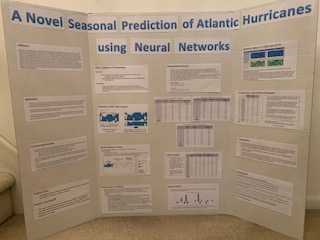A Novel Seasonal Prediction of Atlantic Hurricanes using Neural Networks
Abstract:
Every year, the hurricane season impacts over 80 million people in the United States, creating billions of dollars in property damage and severe disruptions in people’s lives.The ability to predict the strength of the incoming hurricane seasons a couple of months in advance, and with high accuracy, is essential in allowing the government and local townships to better prepare for an effective response that can save lives and substantial losses.
In this project, I propose a novel design for a hurricane strength predictor that uses neural networks and predicts the Accumulated Cyclone Energy index for the incoming hurricane season, using Sea Surface Temperature Maps collected for the month of January, four months in advance.
I analyzed three different predictor designs: Sea Surface Temperature Data for the entire recorded domain, the tropical region, and the tropical-Atlantic region. My analysis showed that the most accurate prediction was given by the full domain predictor, with an average accuracy of 82.3% and a 95% confidence interval of [78.23%, 86.37%]. My experiments showed that my novel design based on neural networks was 30% more accurate in predicting the strength of the incoming hurricane season, when compared to the current predictions issued in May by the National Oceanic and Atmospheric Administration (NOAA) for the 2000-2019 years.
Bibliography/Citations:
No additional citationsAdditional Project Information
Project files
Research Plan:
Project question: Can the strength of the hurricane season be accurately predicted months in advance of the beginning of the tropical Atlantic cyclone season?
Motivation:
Every year, the hurricane season impacts over 80 million people in the United States (Potenza A., 2008). The regions affected by hurricanes may suffer severe damage from destructive high winds and flooding. For instance, Hurricane Harvey and Irma’s costs were estimated to be between $42.5 billion to $65 billion in property damage (Stupak J.M., 2017).
Accurately predicting the strength of the hurricane season well in advance will allow government officials and townships to know what to expect and better prepare. Predicting the next hurricane season is a very difficult task, and the NOAA (National Oceanic and Atmospheric Administration) uses complicated mathematical models for their prediction of the outlook of the season, however the accuracy of the prediction is low.
One metric that NOAA uses to characterize the hurricane strength is the ACE index (Accumulated Cyclone Energy) which characterizes the strength of the overall hurricane season. Previous papers have investigated the possibility of successfully predicting the hurricane strength months in advance, with some encouraging results such as (Latif M., Keenlyside N., Bader J., 2007) and (Villarini G., Vecchi G.A., 2013). (Villarini G., Vecchi G.A., 2013) showed 65% correlation for their prediction based on the Sea Surface Temperature (SST) averages in Tropical and Tropical-Atlantic regions.
This project will investigate the use of neural networks to predict the strength of the upcoming hurricane seasons in advance and with a high accuracy.
Project Goal: Design a neural networks based prediction system for seasonal prediction of Atlantic Hurricanes.
Hypothesis to Investigate: The use of neural networks will significantly improve the prediction accuracy of the hurricane season compared to current predictors because neural networks are able to accurately extract representative features in the data.
Procedure:
- Data collection
Sea Surface Temperature data will be downloaded as images from the Kaplan SST V2 data provided by the NOAA/OAR/ESRL PSD, Boulder, Colorado, USA, from their Website at https://www.esrl.noaa.gov/psd/ iKaplan Extended SST V2 dataset. (NOAA PSD, 2019). January data will be downloaded since it was shown in (Villarini G., Vecchi G.A., 2013) that the highest prediction performance is achieved for the January month.
ACE index values will be downloaded from (NOAA HRD, 2019).
- Data Analysis
- Image Preprocessing
Images will be cropped for various regions of interests: full domain, Tropical region and Tropical-Atlantic regions and training/testing sets will be generated.
- Neural Network Design
A convolutional networks architecture will be designed and implemented in Python, to optimize the prediction accuracy. Parameters to be experimented with include the number of layers, the number of filters, image augmentation (creating additional images to increase the number of training samples), and regularization to avoid overfitting.
- Experimentation
The hurricane strength will be classified into two classes: high and low. Class high if ACE >111, and low otherwise. Data will be split into training, validation and test sets.
The neural network will be trained using the training set. The stopping criteria for training will be the recognition accuracy for the training set, as well as for the validation set, which is a new set not yet learned by the network. The testing set will be used to test the neural network prediction capabilities. Both the validation and testing set are predicted (not learned). The overall accuracy of prediction will be determined for the three types of regions (full domain, Tropical, Tropical-Atlantic), to see which design is best to improve the prediction accuracy.
Materials: Macbook laptop
Risk Assessment: There is no risk associated with this project.
Bibliography
Potenza A. (2018) Why we can’t predict how destructive a hurricane season will be. Retrieved from:https://www.theverge.com/2018/6/1/17416788/hurricane-season-2018-atlantic-outlooks-forcasts-noaa-csu
Stupak J.M. (2017) Economic Impact of Hurricanes Harvey and Irma. Retrieved from: https://fas.org/sgp/crs/misc/IN10793.pdf
NOAA PSD. (2019) Kaplan Extended SST V2. Retrieved from https://www.esrl.noaa.gov/psd/data/gridded/data.kaplan_sst.html
NOAA HRD (2019) North Atlantic Hurricane Basin (1851-2018). Comparison of Original and Revised HURDAT. Retrieved from:https://www.aoml.noaa.gov/hrd/hurdat/comparison_table.html
Villarini G., Vecchi G.A. (2013). Multiseason Lead Forecast of the North Atlantic Power Dissipation Index (PDI) and Accumulated Cyclone Energy (ACE), Journal of Climate, American Meteorological Society.
Latif M., Keenlyside N., Bader J. (2007) Tropical Sea Surface Temperature, vertical Wind shear and hurricane development, Geophysical Research Letters.

